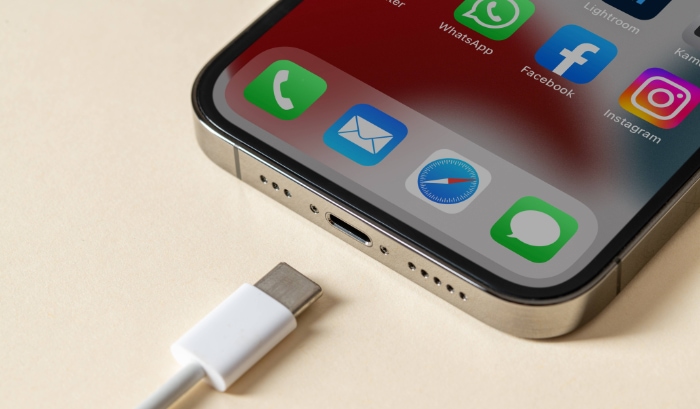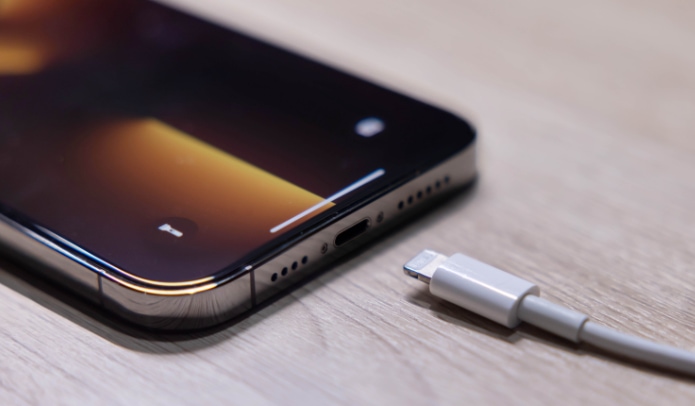5 Reasons Why Your iPhone Charging Port Is Loose

Charging your iPhone should be a seamless experience, but what if you notice the charging port feeling a tad loose? A shaky connection not only disrupts your device’s power supply but can lead to more complex hardware issues down the road. Let’s dive deep into the common causes behind a loose iPhone charging port and the ways to troubleshoot and prevent it.
With the right knowledge, ensuring your iPhone charges effectively can be both effortless and reliable.
Wear and Tear
Every iPhone charging port, like any mechanical component, undergoes a gradual process of degradation. The constant cycle of plugging in and unplugging, although seemingly innocuous, exerts repeated stress on the tiny connectors inside the port.
Over time, this natural process can result in a less secure fit between the charging cable and the port.
The Mechanics of Wear
The charging port comprises small metal contacts designed to establish a firm connection with the charging cable. Each time the cable is inserted or removed, it interacts with these contacts.
As with any metal component undergoing regular friction, these interactions cause wear. The more frequently the device is charged, the faster these contacts might degrade.
The Inevitability of Time
While modern technology is impressive, it isn’t immune to the effects of time. Even with cautious use, the materials within the charging port begin to exhibit signs of wear.
Given enough time, even the most meticulously cared for iPhone may show symptoms like a slightly wobbly charging cable.
Factors Amplifying Wear
Certain behaviors can accelerate wear and tear. Frequently yanking the charger out at an angle, rather than straight out, can exacerbate the wearing down of the metal contacts.
Moreover, using the phone extensively while it’s charging can also contribute to a looser fit, as the continuous motion might place additional strain on the port.
Impact on Charging Efficacy
As wear and tear progress, users might notice intermittent charging or even difficulty establishing a connection. It’s essential to recognize these early signs and take preventative measures to minimize further damage.
Physical Damage
Beyond the subtle effects of daily wear and tear, physical damage poses a more immediate threat to the integrity of an iPhone charging port. Drops, accidents, or external pressures can directly affect the port’s structure, leading to a compromised connection with the charging cable.
Recognizing the sources of physical damage can help in taking protective measures and maintaining the charging port’s functionality.
Accidental Drops and Impacts
Most iPhone users have experienced that heart-stopping moment when their device slips from their grip. Even with protective cases, a direct impact on the charging port area can cause the internal components to shift or misalign.
This misalignment, even if minor, can result in a looser connection when plugging in a charger.
External Pressures
Placing heavy objects on top of the iPhone or accidentally sitting on it can exert significant pressure on the charging port. This pressure can deform the port or its internal connectors, making it harder for the charging cable to fit snugly.
Exposure to Elements
While not as direct as a drop or crush, exposing the iPhone to extreme conditions, such as intense heat, cold, or moisture, can compromise the port’s physical structure. Metal components can expand or contract with temperature fluctuations, while moisture can corrode the connectors.
Repairing Physical Damage
If physical damage is suspected, it’s advisable to inspect the charging port for any visible signs of damage. Bent connectors or debris from a fall can often be the culprits behind charging issues.
In cases of severe damage, seeking professional repair might be the best course of action.
Accumulation of Debris
An often overlooked cause of loose iPhone charging ports is the accumulation of debris. Dust, lint, and other tiny particles can find their way into the port, especially when the phone is kept in pockets or bags.
Over time, this buildup can interfere with the secure connection between the charging cable and the port, leading to charging inconsistencies or even preventing the cable from fitting entirely.
Sources of Debris Buildup
Everyday environments are replete with microscopic particles. From the lint in pockets to the dust in the air, numerous sources can contribute to debris accumulation within the charging port.
- Pocket Lint: Carrying the iPhone in a pocket, especially a lint-prone one, can lead to tiny fibers lodging themselves within the port.
- Environmental Dust: Locations with higher dust levels, such as construction sites or older buildings, can increase the chances of dust buildup.
- Foreign Particles: Accidental spills, sand from a beach visit, or crumbs from a meal can introduce unwanted particles into the port.
Effects on Charging
Debris accumulation may start as a minor inconvenience but can evolve into a significant obstacle. A thick layer of dust or lint can prevent the charging cable’s connectors from making proper contact with the port. This might result in slow charging, intermittent charging, or no charging at all.
Cleaning the Port
Regularly inspecting and cleaning the charging port can prevent debris-related charging issues. Gentle cleaning with a soft brush or compressed air can dislodge particles.
However, caution is advised. Using sharp objects or excessive force can cause more harm than good.
Manufacturing Defects

While iPhones undergo rigorous quality control, no manufacturing process is entirely free from errors. On rare occasions, devices may come off the production line with imperfections in the charging port.
It’s essential to recognize the possibility of a manufacturing defect and understand how to address it.
Identifying a Manufacturing Defect
Manufacturing defects in the charging port are typically evident soon after purchase. Here are some signs:
- Immediate Loose Fit: If the charging cable doesn’t fit snugly from the outset, it might be an indication of a manufacturing error rather than wear and tear.
- Inconsistent Charging Out of the Box: A brand new iPhone that exhibits charging inconsistencies may have a defective port.
Causes of Manufacturing Defects
Manufacturing defects arise from various reasons in the production process:
- Quality Control Oversights: Even with stringent quality checks, some flawed units might slip through.
- Production Line Errors: Issues in the assembly line or machinery malfunctions can introduce defects.
Warranty and Replacement
For those who suspect their iPhone’s charging port issue stems from a manufacturing defect, it’s beneficial to act swiftly:
- Warranty Check: Most new iPhones come with a limited warranty that covers manufacturing defects. If the device is still under warranty, it’s advisable to contact Apple or the retailer.
- Authorized Service Providers: Always seek help from authorized service centers. They are equipped to diagnose and address manufacturing defects accurately.
- Document Everything: Keeping a record of the issue, such as videos or photos showing the problem, can be beneficial during the warranty claim process.
Usage of Third-Party Cables
The allure of third-party charging cables, often due to their attractive price points or unique designs, can be tempting for many iPhone users. However, not all third-party cables are created equal.
Using non-Apple-certified cables can contribute to issues in the charging port, impacting the overall charging experience.
The Allure of Alternative Cables
Third-party cables can offer various benefits that might entice users:
- Cost-Effectiveness: Many third-party cables are available at a fraction of the cost of official Apple cables.
- Variety: These cables often come in diverse designs, lengths, and colors, allowing users to personalize their charging setup.
Potential Drawbacks
Despite the advantages, third-party cables can introduce several challenges:
- Inconsistent Build Quality: Without the stringent standards that Apple-certified products adhere to, the build quality of third-party cables can vary widely. Some might be too thick, thin, or improperly sized for the charging port.
- Material Differences: The metals used in the connectors of non-certified cables might differ from those in official cables. This can lead to faster wear and tear or even potential damage to the port’s internal connectors.
Electrical Risks
Beyond physical fit and wear, there are electrical concerns to consider:
- Mismatched Specifications: Some third-party cables might not match the electrical specifications required for safe and efficient iPhone charging. This mismatch can lead to slower charging, overheating, or, in worst-case scenarios, damage to the iPhone’s internal circuitry.
Apple’s MFi Certification
To ensure compatibility and safety, Apple offers an MFi (Made for iPhone/iPad) certification program for third-party accessory manufacturers. Cables with this certification have met Apple’s standards for design and performance.
- Spotting MFi Cables: Genuine MFi cables typically have a logo that signifies their certification. It’s a good practice to look for this logo when considering a third-party cable.
Signs of a Loose Port
Detecting a loose charging port early on can prevent further complications and preserve the longevity of an iPhone. While some signs are overt, others may be subtle, making it essential for users to remain vigilant to any changes in their device’s charging behavior.
Intermittent Charging
One of the most noticeable signs of a loose port is when the iPhone starts charging intermittently. The device might begin charging upon connecting the cable, only to stop a few moments later.
This can be especially pronounced if the cable or the device is moved slightly during the charging process.
Wobbly Cable Connection
A clear indication of a problem is if the charging cable doesn’t sit firmly within the port. A slight wobble or the need to adjust the cable to a particular angle for effective charging can be telltale signs of a loose connection.
Difficulty Inserting the Cable
If inserting the charging cable becomes progressively challenging, or it feels like something is obstructing its path, it might be an indication of a misaligned port or accumulated debris. The cable should slide in smoothly without any undue resistance.
Inconsistent Connection Sound
Every time a charger is connected to an iPhone, a distinct sound or vibration confirms the connection. If this sound becomes inconsistent or is occasionally absent, it might hint at a less than perfect connection due to a loose port.
Device Fails to Charge
The most alarming sign is when the iPhone fails to charge altogether. While this can be due to several reasons, including a faulty battery or software issues, a compromised charging port is a common culprit, especially if other symptoms are present.
Conclusion
Maintaining an iPhone’s charging port in optimal condition is essential for a seamless user experience. Over time, various factors like wear and tear, physical damage, debris accumulation, manufacturing defects, and the use of third-party cables can contribute to a loose charging port.
Recognizing the potential causes and the signs of a compromised port can empower users to take timely action. Whether it’s opting for certified charging cables, regular cleaning, or seeking professional repair, proactive measures can significantly extend the device’s lifespan and ensure consistent performance.
It’s crucial to remain vigilant and address any irregularities promptly, ensuring the device remains a reliable daily companion.



